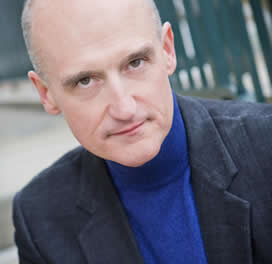If the first requisite for a great orchestra is a great hall, one wonders how the Greensboro Symphony has been doing so well despite the dearth of great halls in Greensboro. At present, Dana Auditorium (on the Guilford College campus) is the best Greensboro has to offer to symphony orchestras and will be so for the foreseeable future while the long-awaited Tanger Center plants itself in the center of Greensboro and grows to fruition, sometime late in 2019 according to optimists. The orchestra’s former home, War Memorial Auditorium, part of the Coliseum complex (and razed in 2014), had its share of acoustical problems, including an overly-wide stage on which it was a challenge for the players to hear each other – a sine qua non for live acoustical performances. (Amplified groups can perform anywhere and have tech tricks to compensate for almost any acoustical deficiency).
The Greensboro Symphony’s opening concert of the 2017-18 season took place in the Carolina Theatre, a venerable and genuinely comfortable hall on Greene Street in downtown Greensboro. Decorated with neoclassical sculpture and gilded bas-reliefs set in muted reds and sandstone, the hall has a gigantic shell shape with no straight walls and is some 20 rows of seats deep and over 40 seats wide. The ceiling soars over the immense main floor and small balcony and all attention is directed to the not-so-large stage where the orchestra was seated in front of a screen (or scrim) upon which part of the evening’s fare was presented. An orchestra shell would have focused the sound, much of which disappeared in the high fly space over the stage and into the cloth draped wings.
But the need for a movie screen trumped the need for a shell. Eclectic filmed introductions, produced by David Donnelly and featuring Greensboro native and sitcom star Ken Jeong, Maestro Dmitry Sitkovetsky and other musicians from the Greensboro area preceded each of the four works on the program. Known as Doctor Ken, Jeong was quite entertaining as he wove his own musical studies into a fabric extolling the virtues of a musical education. Indeed, I wished that every mover and shaker, politician, financier and educator might hear his and others’ words!
The concert itself, when one finally got down to it, was fairly standard in format, starting with the charming and effervescent Overture to Lo Speziale, by Franz Josef Haydn, one of the 15 operas he composed. The work sparkled with staccato repeated notes, and the second section spotlighted the outstanding principal flutist, Debra Reuter-Pivetta, who rose at center stage, adding to the visual element.
After a further filmed introduction highlighting the violin mastery of Maestro Sitkovetsky, the maestro returned to play (and lead) the ever-popular Violin Concerto No. 3 in G, K.216, composed by Mozart while he was still a teenager. Sitkovetsky has a gorgeous tone and is one of the finest violinists around. I was impressed that he maintained the high level of musical interest in the second movement, a decidedly slow Adagio. And the Rondo third movement was sheer delight, especially the moments where Mozart switches the predominant rhythm to duple after so much triple meter.
After a lengthy intermission, we were treated to Chopin’s Prélude No. 15 (Opus 28) in D-flat, in a transcription for strings arranged by Sitkovetsky – this was particularly successful and played at a very calm tempo which the sustained nature of strings permits more readily than the more percussive nature of the original piano. (One remembers, of course, that Sitkovetsky’s mother is the legendary pianist, Bella Davidovich.
Alexander Borodin was an accomplished amateur musician, and his few works are quite popular with audiences. His gift for melody has always been apparent and has caused modern composers to borrow his music frequently. The Symphony No. 2 in B minor begins austerely, with the entire orchestra playing in unison (and octaves). The first and last movements are complex and interesting while the second movement is a difficult scherzo-like piece with many rapidly repeated notes, stunningly played by the horn section!
The filmstrips were all interesting and added a new dimension to the concerts, but the transition between film and live orchestra was choppy and awkward: end film, lights up, enter soloist or conductor with spotlight, audience applause and bows and start the music – why couldn’t the music start in the dark at the end of the film, making a seamless transition?
The concert will be repeated Saturday in the same venue. See our sidebar for more details.













